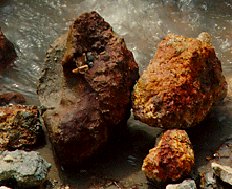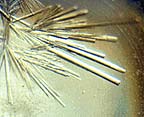|
A volcano-loving bug offers clues as to what
makes life possible in extreme conditions.
by Dr David Noever
They may be small, but they're very hot. They're the
archaea, an ancient branch of microbial life on Earth discovered
by scientists in 1977. Unlike the better known bacteria and eukaryotes
(plants and animals), many of the archaea can thrive in extreme
environments like volcanic vents and acidic hot springs. They can
live without sunlight or organic carbon as food, and instead survive
on sulfur, hydrogen, and other materials that normal organisms can't
metabolize. It may sound like science fiction, but many scientists
are working rapidly to explore the biology as well as the practical
benefits of these life forms.
An enzyme, alcohol dehydrogenase (ADH),
is derived from a member of the archaea called Sulfolobus solfataricus.
It works under some of nature's harshest volcanic conditions: It
can survive to 88 deg. C (190 deg. F) - nearly boiling - and corrosive
acid conditions (pH=3.5) approaching the sulfuric acid found in
a car battery (pH=2). ADH catalyzes the conversion of alcohols and
has considerable potential for biotechnology applications due to
its stability under these extreme conditions. To understand how
it works, scientists first need to learn its basic structure. For
this, an Italian research team went to space.
After collecting Sulfolobus solfataricus
from the Solfatara volcanic area near Naples, the Italian team used
the ADH enzyme for crystallization aboard the Space Shuttle.
Compared to crystals grown in Earth's
gravity, the space crystals showed an improved quality of nearly
35%, and the researchers obtained diffraction data with a significantly
higher resolution, indicating reduced disorder. Scientists hope
to use the space grown crystals to improve the biological understanding
of how these molecules work based on a detailed knowledge of their
shape and exact atomic positions.

The red of
these rocks is produced by sulfolobus solfataricus, near
Naples, Italy.
|
A fundamental question posed by the
space shuttle investigation is: what features of these volcanic
microbes' metabolism allows for such thermal stability in their
enzymes? If unusual characteristics in their metabolism can be identified
and studied, the transfer of this knowledge is almost immediate
to applications in environmental cleanup, pollution prevention,
or energy production. Many researchers envision a range of medically,
industrially, and environmentally useful compounds derived from
the extreme heat-loving, or "hyperthermophilic" Archaea.
Biomolecules from these organisms are
active at temperatures that generally degrade normal cellular molecules,
such as enzymes, lipids, and nucleic acids.
When stored at room temperature, these
molecules from volcanic microbes are in the "deep freeze" compared
to their normal lives, thus offering tremendously extended shelf-life
and stability in commercial use.
The first Archaea-related products
were DNA polymerases for the research market. For example, New England
Biolabs, a Beverly, Mass.-based biotechnology company, sells Vent
and Deep Vent polymerases, used in DNA sequencing. These enzymes
originally were isolated from hyperthermophiles associated with
oceanic hydrothermal vents. Without analysis of these fiery microbes,
neither the modern identification of human genetic diseases nor
the use of DNA evidence in legal courts would even have been realized.
Researchers say that the heat and geochemical
conditions in volcanic regions may be similar to conditions that
existed on the young, water-covered, cooling Earth. Almost like
a creature from science fiction, the volcanic microbe is different
from the two other basic branches of life: bacteria and eukaryotes.
The prokaryotes are the bacteria, while eukaryotes are the so-called
higher forms of life, including humans, plants and animals.

In the microgravity
environment of the Space Shuttle scientists are able to grow
macromolecular crystals with a high degree of purity. Using
a process called "X-ray crystallography" they can map the
structure of proteins and learn how they work.
|
A major difference is that eukaryotes
put their genes inside a nucleus, while prokaryotes do not. In the
archaea, there is no nucleus, but many genes behave like those in
higher organisms. Archaea are thought to have a common ancestor
with bacteria, but billions of years ago the third domain, eukaryotes,
broke off from archaea, eventually developing into plants, animals
and us. Archaea include microbes that live at the extremes of the
planet - the very, very cold, hot or high-pressure places that no
other form of life could endure.
As such, archaea are the extremophiles
who boldly thrive where no other life form would go. Some scientists
have suggested that as such, archaea may represent the earliest
form of life and thus may be the most likely form of life existing
on other planets. About 500 species of archaea are now identified,
but speculation may not be far off in projecting that given the
difficulties of collecting and classifying them, there may be a
million others. The life form is thought to produce about 30 percent
of the biomass on Earth, much of it in the Antarctic Ocean.
In fact, as far back as 1994, Myrna
Watanabe, a biotechnology consultant, wrote that the existence of
this third branch of life "here on Earth has led scientists to realize
that planets they hitherto assumed to be lifeless might support
life."
Some estimates suggest that human biology
depends on the action of nearly half a million different enzymes
and proteins. In fewer than 1 case in 100, we have a three-dimensional
picture of shape and function of these complex chemicals. Since
1984, the Space Shuttle has carried experiments to determine the
structures of large, biologically important molecules. This research
has compiled results for a host of human diseases ranging from insulin
(for the control of diabetes) to one enzyme called reverse transcriptase
that can be blocked to inhibit HIV infection.

|
In comparing more than 33 such different
biological molecules crystallized on the Shuttle and also in similar
conditions on earth, space produced larger space crystals in 45%
of the cases and new structures in nearly 20% of the cases. As many
as half the space crystals had a 10% or better improvement in the
x-ray brightness or the crystallographic resolution. Both are important
to determining these large molecules' shape and exact atomic positions.
Much work remains to be done in uncovering
the shape and detailed way that these extreme microbial molecules
achieve their thermal stability. In a controlled study comparing
space grown crystals with the best data ever previously obtained
from ADH crystals formed on Earth, the Italian team found that the
"the microgravity-grown crystals displayed increased stability when
exposed to X-rays." This finding moves the investigation closer
to revealing the biological function of these complex molecules.
According to their report, although
future flights will be required to solve the fully three-dimensional
picture of the molecule, the Space Shuttle provided larger, more
ordered and more radiation-stable examples of this microbial enzyme;
and as our knowledge grows we are being offered increasing and important
insights as to what makes life possible in extreme conditions.
|
